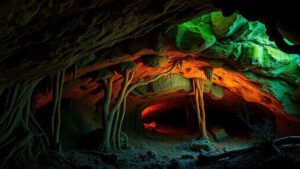Petrified Grasslands: Fossilized Roots and Plants from Earth’s Past
Petrified Grasslands: Fossilized Roots and Plants from Earth’s Past
Petrified grasslands are fascinating geological formations that serve as a window into the planets ancient ecosystems. These unique sites offer valuable insights into the flora that once thrived in what are now arid or semi-arid regions. For rockhounds and mineral collectors, understanding the nature of these petrified remains can enhance their appreciation and guide their collecting practices.
The Science Behind Petrified Grasslands
Petrification is a process where organic materials, such as plants and trees, are transformed into stone through the gradual replacement of their organic compounds with minerals, primarily silica. This process often occurs in environments rich in volcanic activity, where ash and mineral-laden waters saturate the vegetation. Over time, these elements interact with the organic matter to create fossilized remains.
In particular, in grasslands, roots, stems, and leaves undergo this transformation, providing a snapshot of the ecological conditions of the era when they existed. Scientists estimate that some of the oldest petrified grasslands date back to the late Paleozoic era, approximately 300 million years ago, during which time Earth saw dramatic shifts in climate and vegetation.
Petrified grasslands exhibit several distinct characteristics that make them particularly intriguing to collectors:
- Petrified Roots: These preserved structures often display intricate details, showcasing the complex network of root systems that supported ancient flora. r size can vary, with some roots measuring several inches in diameter.
- Petrified Leaves and Stems: Fossilized leaves may be found in various forms, often retaining their original texture and coloration. Measurements of the leaves typically range from one to several inches in length.
- Mineral Composition: The mineralization process can result in a range of colors in petrified specimens, driven by the minerals present during fossilization. Common minerals include quartz, calcite, and hematite, contributing vibrant hues from reds to greens.
Petrified Grasslands Around the World
Several notable locations around the globe contain significant deposits of petrified grasslands:
- Petrified Forest National Park, Arizona: This park is renowned for its vast collection of fossilized trees but also contains areas where grassland fossils are present. geological features vary from Multi-color fossilized wood to vibrant mineral deposits.
- Oodnadatta Track, Australia: This region is rich in sedimentary rocks that have preserved ancient plants. Some samples here are believed to be over 100 million years old, showcasing a diversity of prehistoric plant life.
Practical Tips for Collectors
If you are keen to start your journey in collecting petrified remains or if you are looking to enhance your current collection, consider the following tips:
- Research Local Regulations: Before collecting, ensure youre familiar with the laws regarding fossil collection in your area. Many regions have strict guidelines to protect paleontological sites.
- Use Proper Tools: A basic field kit that includes a geological hammer, chisel, and safety goggles will be invaluable for extraction and preservation.
- Join Local Organizations: Engaging with rockhounding clubs and fossil collecting groups can provide access to exclusive collecting sites and expert knowledge.
- Document Your Finds: Keeping detailed records of your collection, including where you found each piece and the condition it was in, can enhance your understanding and enjoyment.
The Importance of Preservation
Petrified grasslands not only hold aesthetic and educational value but also serve critical roles in understanding ancient climates and ecological shifts. As these sites face threats from erosion and human activity, the call for preservation grows louder.
By increasing awareness about the importance of these fossilized landscapes, collectors and geologists alike can advocate for better preservation practices. Participation in conservation efforts ensures future generations can similarly explore and appreciate these remarkable windows into Earths past.
Conclusion
Petrified grasslands are more than mere relics of the past; they represent the dynamic history of life on our planet. Their fossilized roots and plants capture a snapshot of prehistoric ecosystems, enriching our understanding of biodiversity.Â
For rockhounds and mineral collectors, these petrified remains offer both an exciting collecting opportunity and an avenue to connect with Earth’s ancient tales. By adhering to best practices in fossil collection and championing preservation efforts, you contribute to the ongoing legacy of these extraordinary natural phenomena.



